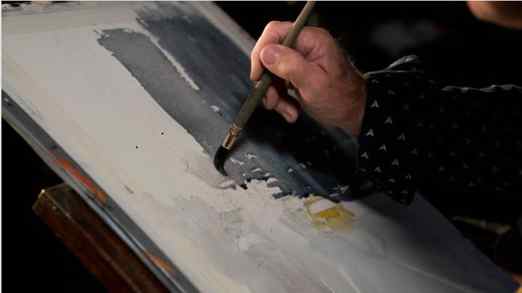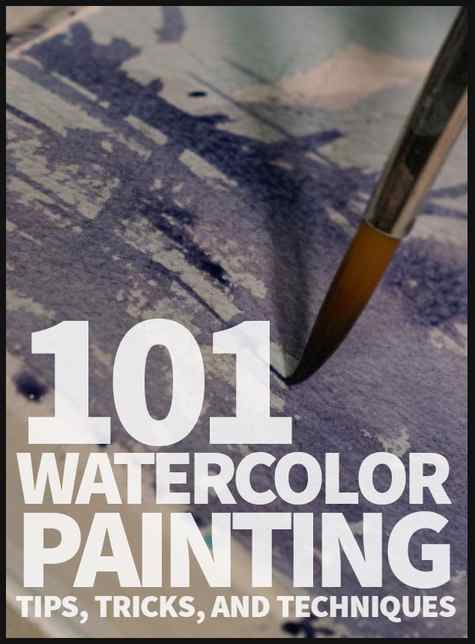This watercolor lesson is painted at 49″ by 22″ using acrylic watercolor and various techniques described and illustrated in detail.
101 Watercolor Painting Ideas, Tips, and Techniques – A Free Guide

Want to learn how to paint with watercolor? Don’t think you have the talent or skill? We can teach anyone to paint – start with this free guide that’s full of watercolor painting ideas.
This is a very special report because we’ve asked 37 of the world’s best watercolor artists to give their best tips and painting insights.
Inside you’ll discover watercolor painting ideas, tips and techniques such as:
- 7 Words of Wisdom From Master Joseph Zbukvic
- 3 Ways To Keep Your Watercolors Fresh and Loose
- Sandra Strohschein’s Tip On How To “Wake Up” Your Watercolors
- What Most New Watercolor Artists Do That Makes The Painting Worse
- Brienne Brown’s Technique on Painting Leaves
- Angus McEwan’s 6 Secrets to Better Snow Scenes
- Keiko Tanabe’s Intuitive Way In Choosing Subjects
- Yong Hong Zhong’s 5 Fail-Safe Techniques for Painting Greens
- Shuang Li’s Advice On Painting Crystals and Using Transparent Watercolor
- Frank Constantino’s 3 Tips When Sketching With Watercolor
- How To Know When To Add The Next Wash, by Brienne Brown
- What To Do When Plans Go Awry
- A Quick Lesson On 2 Types of Shadows
- How To Use Elements of Design To Your Advantage, by Ryan Fox
- 2 Tips For Keeping Your Shapes Simple
- John Salminen’s Must-Have Brush
- 6 Ways to Kickstart Your Creativity With Color Studies
- Iain Stewart’s Sketch Bag Supply List
- PLUS: An Invitation to Meet & Paint With Over 20 Of The World’s Best Watercolor Artists!
- And much, much more!

- TAGS
- Advice for Artists
- Plein Air Watercolor
Watercolor Blooms

Mary Ann Boysen was raised in Mississippi. Her interest in art started from an early age, but it was at college when Mary began to indulge her passion with increased devotion. In watercolor tutorial, Mary shows how you can turn watercolor blooms into wonderful works of art.
Chysanthemum, Watercolor Painting Lesson
Lian Quan Zhen is a watercolor artist and Chinese painter / teacher both in the US and overseas. Whilst practising medicine as a family physician in Canton Province, China, Lian emmigrated to the US in 1985, obtained a Bachelor of Arts Degree from University of California at Berkeley in 1992 and a Master of Architecture Degree from MIT in 1996. In this floral watercolor lesson, Lian uses techniques such as blowing the paint to add spontaneity and interest to his paintings.
The artist works over a wet wash which sets the tone, and leaves two oval spots to later add a couple of water droplets.
Learn to Paint Trees
This watercolor lesson is three in one, and includes an autumn tree and a cluster set against a lakeside bank.
Work in layers from light to dark
Because watercolor is a transparent medium, it’s important to build up your layers from lighter colors to darker colors. In the little mountain scene below, you’ll see that I started with my yellow sky, then did the light purple mountain in the distance, and finally the dark mountain in the front.
Tip: When working in layers, let each layer dry before moving on to the next. This takes a little bit of patience, but it’s worth it! If the paper is still wet when you apply the next layer, you’ll end up with a strange, blendy mess.



Fade edges when layering
You may notice in the photos above that I let the paint slightly bleed over the lines while I built up the layers. This was intentional! Like I mentioned before, since watercolor is transparent, the lower layer is visible below the upper layer. It’s important to soften the edge that will be overlapped so that you don’t see a hard edge beneath the second layer. This will make more sense in the photos below.

Tip: To soften the edge, paint the shape you want, and then fill your brush with clear water. Run the clear brush along the edge of your painted shape, gently touching the paint so that the water pulls it into the paper.


As shown in the righthand image below, a hard edge is visible beneath the second layer, whereas the softer edge is much more seamless.

“Erase” by wetting and lifting
Watercolor can be fairly unforgiving, but it IS possible to fix mistakes! Let’s say a stray droplet of paint went somewhere it shouldn’t have. Before it dries, you can remove it by wetting down the spot with a brush full of clear water and then blotting the wet spot with a paper towel.
Tip: You do need to work quickly, because as soon as that water evaporates, the pigment will be fairly well absorbed into the paper and much harder to erase. You can still lighten, or nearly erase the dried pigment, by scrubbing your wet paintbrush over top of the spot and blotting with a paper towel. This won’t fully remove the dried pigment, but it will lighten it some.





